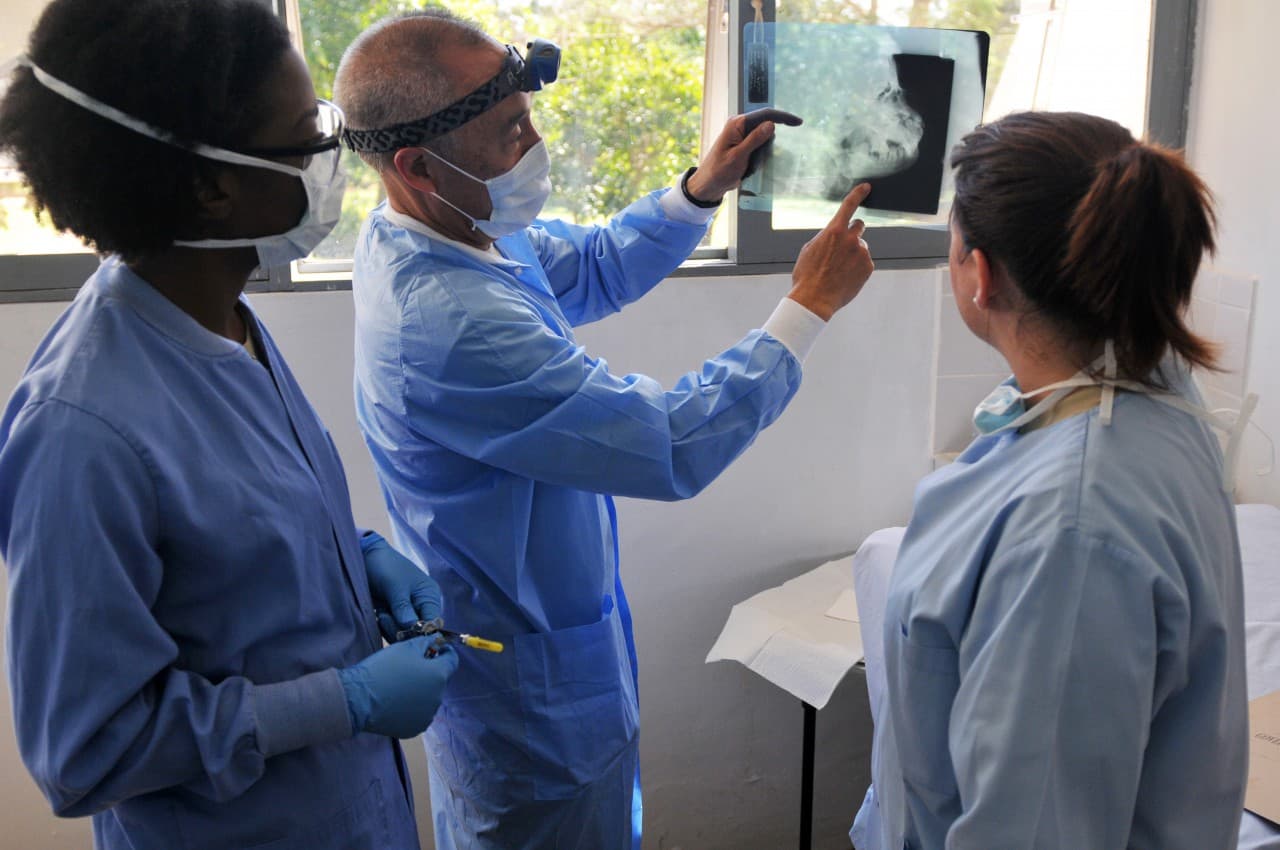Advertisement
Put Back The Teeth? Why We Separate Dental And Medical Care
ResumeMy colleague Stef Kotsonis stops me in the hall at work every few weeks with a new pearl of health care wisdom. Last week, it began with the story of three teeth that had to come out.
"I’m getting implants put in, dental implants," Kotsonis explains, an index finger pulling back his lower lip. "Two down here, bottom left, and one up here."
He pauses to grin.
"So when they tell you to chew on the other side, it’s a much more subtle dance than that." Kotsonis is giggling now. "There’s a foxtrot going on at meal time."
Paying to fix the problem is no laughing matter.
"Our dental plans are awful compared to our health plans," Kotsonis says. "I’m paying thousands of dollars for these [implants]. It’s, boy, it’s breaking the family bank."

Kotsonis is also worried about the lack of coordination between his primary care physician and dentist.
"My own doctor has no idea what’s going on in my dentist’s office," Kotsonis says. "She doesn’t know if I’m having implants, she doesn’t know if I’m being given these antibiotics, she doesn’t know if these antibiotics clash with anything else she’s doing. And it just seems to me that this is exactly the sort of thing, in this information age, that should be shared."
How did this happen, this decision to treat the teeth and gums separate from the rest of the body? There is lots of proof that poor oral health is tied to heart disease, diabetes, HIV and can lead to death. So why, in this era of integrated medicine, do we continue to carve out the teeth? And is anyone trying to put them back?
First, the history.
"When you think of medical and dental care, it was pretty much together through the centuries," says Dr. James Gutmann, editor of the Journal of the History of Dentistry. That started to change in the 17th century with Pierre Fauchard, a Frenchman who became known as the the father of modern dentistry. Fauchard aimed to elevate dentistry as its own science, separate from the doctors or alchemists or barbers who regularly pulled teeth.
The first dental school in the U.S. opened in Baltimore in 1840 but "it did not focus that much on medicine," says Gutmann. "It focused more on being a good craftsman, and they were tremendously good craftsmen."
Dentistry shifted back toward medicine in the early 1900s, continues Gutmann, as dentists and doctors realized that an infection in a tooth could spread to other parts of the body. Doctors and dentists shared classes in some schools, but the idea of dentistry as more of a craft than as life saving care stuck. In the 1960s and '70s, funding for dental research was on the rise, but health care became linked to health insurance, and teeth were not included.
"That’s when we started to see a separation because there was no dental insurance as far as I know," Gutmann says. "There was just no coverage whatsoever."
Today, in Massachusetts, community health centers are the only places where you’ll routinely find a dentist practicing alongside a doctor.
"The mouth is part of your body. It’s just an important as your eyes."
Joan Pernice, Massachusetts League of Community Health Centers
"The mouth is part of your body," says Joan Pernice, director of clinical health affairs at the Massachusetts League of Community Health Centers. "It’s just an important as your eyes,"
Including dentists fits the philosophy of community health centers, adds Pernice, and it makes sense.
"We know that gum disease can potentially cause systemic issues, especially with someone who’s already compromised because of a chronic illness like diabetes or cardiovascular disease," Pernice says.
With a growing body of evidence that links the health of the teeth and gums to the rest of the body, the medical and dental worlds are beginning to forge connections. Several national groups are trying to make sure dentists are included in models for Patient Centered Medical Homes. Northeastern University has a new program that will build oral care into nursing, pharmacy and physician assistant degrees. There’s a pilot project in Massachusetts that teaches pediatricians to give children an annual fluoride varnish.
Dr. Michael Wasserman, president of the Massachusetts Dental Society, says dentists welcome these changes.
"This is just what the trend is," Wasserman says. "We are going toward a more integrated version of health care."
Wasserman is serving with doctors on an oral health committee the Massachusetts Medical Society recently formed. Committee Chairman Dr. Hugh Silk says it's the first time the medical society has invited dentists into its planning process.
"We even go so far as to say, what if the two professions came together and we weren’t working on things like medical approaches or dental approaches, but health approaches?" Silk says.
So can Silk imagine a time when dental and medical care, as well as the separate insurance systems, unite?
The federal Affordable Care Act does include an experiment. It requires that insurers offer dental coverage for children. But dental and medical can be separate plans with separate deductibles and other charges, and many parents aren't buying into this added expense.
Still, Silk is hopeful.
"Major things have happened in our lifetime, around the world, where things you thought would never happen have happened," Silk says. "Maybe we'll get to a point where people will revisit. Look, we have dental insurance and we have medical insurance, and it's time for health insurance, so I think there’s hope."
